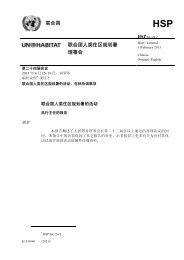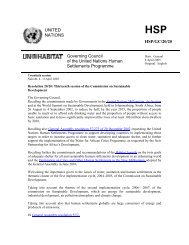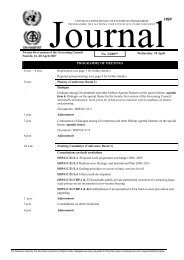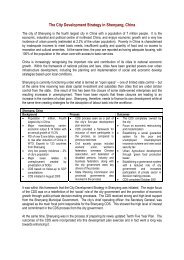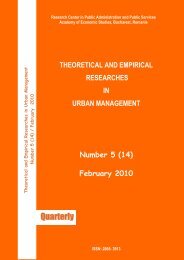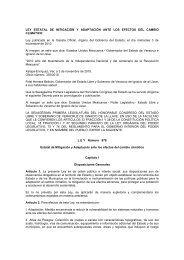Harmonious cities - UN-Habitat
Harmonious cities - UN-Habitat
Harmonious cities - UN-Habitat
You also want an ePaper? Increase the reach of your titles
YUMPU automatically turns print PDFs into web optimized ePapers that Google loves.
IN-FOCUS Transport<br />
The bicycle and new e-bikes are a favourite mode of transport for many Chinese<br />
a working prototype of the Roboscooter, a<br />
lightweight, folding electric motor scooter,<br />
developed with Sanyang Motors and Taiwan’s<br />
Technology Research Institute.<br />
“Barcelona, Zaragoza and Taipei have<br />
shown a level of interest in adopting it. The<br />
Roboscooter will be a precursor to the City<br />
Car, because the concepts are the same,” said<br />
Mr. Chin.<br />
The precedent for this type of shared personal<br />
transport is the bicycle-sharing scheme<br />
that has been set up in European <strong>cities</strong>. The<br />
first such programme was initially launched<br />
three years ago in Lyon, France’s third largest<br />
city, as an ambitious project to cut traffic,<br />
reduce emissions, improve parking and<br />
enhance the city’s image as a greener, quieter<br />
more relaxed place. Called Cyclocity, it was<br />
deemed so successful that Barcelona, Stockholm,<br />
Toulouse and Paris quickly followed<br />
suit with their own systems.<br />
34<br />
u r b a n<br />
WORLD<br />
November 2008<br />
Ph o t o © kA r e n Wi n t o n<br />
“The city’s 3,000 rental bikes have racked<br />
up about 16 million kilometres since the programme<br />
started in May 2005,” said Lyon’s<br />
Deputy Mayor, Jean-Louis Touraine. “We believe<br />
we have saved 3,000 tonnes of carbon<br />
dioxide from being spewed into the air. Over-<br />
“The ultimate goal is to create a system<br />
whereby people can select an appropriate<br />
vehicle for the mission at hand, be it scooter,<br />
bicycle or car.”<br />
all vehicle traffic in the city is down by four<br />
percent and bicycle use has tripled, as the<br />
programme has boosted a boom in private<br />
bicycle use and sales.”<br />
The Cyclocity concept, was developed from<br />
the communal ideals of the hippy 1960s and<br />
1970s, when bikes were left on the street for<br />
anyone to use. Eventually these “bicycle sharing”<br />
schemes failed as the bicycles were either<br />
stolen or became irreparable.<br />
Cyclocity relies on sturdier vandal-proof<br />
bicycles and a credit card or refundable deposit<br />
is required to discourage theft.<br />
“It has completely transformed the landscape<br />
of Lyon – everywhere you see people<br />
on bikes,” said M. Touraine. “The programme<br />
was designed not just to modify the equilibrium<br />
between transport modes and reduce air<br />
pollution, but also to modify the image of the<br />
city and to have a city where humans occupy<br />
a larger space.”<br />
The Bicing system, set-up in Barcelona<br />
last year, is jointly funded through streetcar<br />
parking fees, which contribute €2.23 million<br />
a year and also the yearly subscription fee of<br />
€24, which makes it the cheapest transport<br />
option available.<br />
The first 30 minutes are free and thereafter<br />
increase in half-hour blocks of a €0.30<br />
charge. Use of two hours or more is discouraged<br />
with a €3 charge per hour. This ensures<br />
that each bicycle is used between 10 and 15<br />
times a day.<br />
Carmen Gramage, an office worker who<br />
lives just outside the centre of Barcelona, says<br />
that it gives an incredible sense of freedom.<br />
“It’s a great concept. I use it almost everyday.<br />
Most of the time it’s faster than the bus<br />
or metro, especially for short distances, a lot<br />
cheaper and it helps reduce pollution.”<br />
The bicycle stations are conveniently<br />
linked into already existing metro stations,<br />
bus stops and car parks to assist in seamless<br />
transport connections.<br />
Due to its success and popularity with users<br />
many other <strong>cities</strong> are keen to introduce<br />
their own systems. These include London,<br />
Dublin, Sydney, Melbourne and Toronto.<br />
The bicycle itself is also undergoing technological<br />
improvements. Synonymous with<br />
China for years as a form of transport, it still<br />
holds appeal to those Chinese who have not<br />
been caught up in the wave of wealth sweeping<br />
across the country. More than 20 million<br />
e-bikes — bicycles with electric motors that<br />
assist the rider — were built in 2007, according<br />
to China’s Clean Revolution, a new report<br />
by Climate Group.<br />
The e-bike outpaced domestic auto sales<br />
in 2007 two to one, and holds a market value<br />
worth USD 6 billion. Giant Bike Co., one of<br />
the largest bicycle companies in the world,<br />
makes the e-bike and is aiming to produce<br />
at least five new models and five upgrades of<br />
previous models every year, which will enable<br />
the company to ship over a million e-bikes<br />
each year to <strong>cities</strong> all over the world.<br />
Merging all three systems is what the team<br />
at MIT are aiming for. “The ultimate goal is to<br />
create a system whereby people can select an<br />
appropriate vehicle for the mission at hand,<br />
be it scooter, bicycle or car,” said Mr. Chin.<br />
Changing people’s ideas about transport is<br />
also a key for the future systems to work. “The<br />
technology is here and the time is ripe.” u









